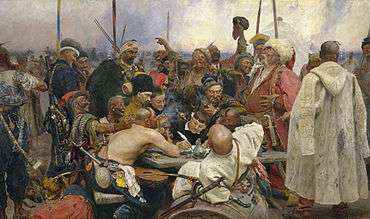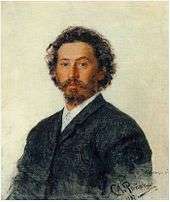Reply of the Zaporozhian Cossacks
 | |
| Artist | Ilya Repin |
|---|---|
| Year | 1880–1891 |
| Medium | Oil on canvas |
| Dimensions | 203 cm × 358 cm (80 in × 141 in) |
| Location | State Russian Museum, Saint Petersburg |
Reply of the Zaporozhian Cossacks to Sultan Mehmed IV of the Ottoman Empire, also known as Cossacks of Saporog Are Drafting a Manifesto (Russian: Запорожцы пишут письмо турецкому султану), is a painting by Russian artist Ilya Repin. The 2.03 m (6 foot 7 inch) by 3.58 m (11 foot 9 inch) canvas was started in 1880 and finished in 1891. Repin recorded the years of work along the lower edge of the canvas. Alexander III bought the painting for 35,000 rubles, at the time the greatest sum ever paid for a Russian painting. Since then, the canvas has been exhibited in the State Russian Museum in Saint Petersburg.
Context
Reply of the Zaporozhian Cossacks depicts a supposedly historical tableau, set in 1676, and based on the legend of Cossacks sending a reply to an ultimatum of the Sultan of the Ottoman Empire, Mehmed IV. The original reply, if it ever existed, has not survived; however, in the 1870s an amateur ethnographer from Yekaterinoslav (today Dnipro), Ya. Novitsky, found a copy made in the 18th century. He gave it to historian Dmytro Yavornytsky (1855-1940), who by chance read it to his guests, among whom was the painter Ilya Repin. Repin became curious about the story and in 1880 started the first of his studies.
Zaporozhian Cossacks (from 'beyond the rapids', Ukrainian: za porohamy), inhabiting the lands around the lower Dnieper River in Ukraine, had defeated Ottoman Empire forces in battle. However, Mehmed demanded that the Cossacks submit to Turkish rule. The Cossacks, led by Ivan Sirko, replied in an uncharacteristic manner: they wrote a letter, replete with insults and profanities. The painting exhibits the Cossacks' pleasure at striving to come up with ever more base vulgarities. During Repin's time, the Cossacks enjoyed great popular sympathy. Repin also admired them: "All that Gogol wrote about them is true! A holy people! No one in the world held so deeply freedom, equality, and fraternity."[1]
Sultan Mehmed IV to the Zaporozhian Cossacks:As the Sultan; son of Muhammad; brother of the sun and moon; grandson and viceroy of God; ruler of the kingdoms of Macedonia, Babylon, Jerusalem, Upper and Lower Egypt; emperor of emperors; sovereign of sovereigns; extraordinary knight, never defeated; steadfast guardian of the tomb of Jesus Christ; trustee chosen by God Himself; the hope and comfort of Muslims; confounder and great defender of Christians - I command you, the Zaporogian Cossacks, to submit to me voluntarily and without any resistance, and to desist from troubling me with your attacks.
--Turkish Sultan Mehmed IV
The Cossacks' reply came as a stream of invective and vulgar rhymes, parodying the Sultan's titles:
Zaporozhian Cossacks to the Turkish Sultan!O sultan, Turkish devil and damned devil's kith and kin, secretary to Lucifer himself. What the devil kind of knight are thou, that canst not slay a hedgehog with your naked arse? The devil shits, and your army eats. Thou shallt not, thou son of a whore, make subjects of Christian sons; we have no fear of your army, by land and by sea we will battle with thee, fuck thy mother.
Thou Babylonian scullion, Macedonian wheelwright, brewer of Jerusalem, goat-fucker of Alexandria, swineherd of Greater and Lesser Egypt, pig of Armenia, Podolian thief, catamite of Tartary, hangman of Kamyanets, and fool of all the world and underworld, an idiot before God, grandson of the Serpent, and the crick in our dick. Pig's snout, mare's arse, slaughterhouse cur, unchristened brow, screw thine own mother!
So the Zaporozhians declare, you lowlife. You won't even be herding pigs for the Christians. Now we'll conclude, for we don't know the date and don't own a calendar; the moon's in the sky, the year with the Lord, the day's the same over here as it is over there; for this kiss our arse!
- Koshovyi otaman Ivan Sirko, with the whole Zaporozhian Host.
.jpg)
While working on the original version, Repin in 1889 began work on a second version. This work he never finished. The second version of "The Cossacks" the artist tried to make more "historically authentic". In 1932 it was presented by the Tretyakov Gallery to the Kharkiv Historical Museum. In 1935, it was moved to the Kharkiv Art Museum, where it is now stored. This canvas is slightly inferior in size and quality to the original version, and is, as it were, the unofficial variant. Vladimir Gilyarovsky, a popular journalist, was one of the models who posed for Repin.
Cultural references
- The French poet Guillaume Apollinaire wrote a versified version of the letter ("Réponse des Cosaques Zaporogues au Sultan de Constantinople") as part of his poem "La Chanson du mal-aimé" in his collection of poems Alcools (1913).
- This versified version of the letter has been set to music by the French singer-songwriter Léo Ferré, who composed a whole oratorio on La Chanson du mal-aimé for soloists, choir and orchestra (1953). Verses were also set to music by Dmitri Shostakovich in his "Symphony Number 14", amongst other poets (Lorca, Rilke) writing about death.
- Art critic Clement Greenberg selected Repin's painting as a bad example of "kitsch" in his influential essay Avant-Garde and Kitsch (1939).[2]
- The writing of the letter is depicted in the film Taras Bulba (2009).
- The trailer of the "Cossacks" expansion to the video game Europa Universalis IV includes an altered version of the reply of the Zaporozhian Cossacks (2015).
- The game Cossacks: European Wars have the central detail of a picture in their logo.
Reproductions
Several full-size copies of the Repin painting exist, including a famous reproduction by Paul Porfirov (Repin's student), currently held by the Cincinnati Art Museum.
References
- ↑ http://www.infoukes.com/history/cossack_letter/
- ↑ Greenberg, Clement (1939). "Avant-Garde and Kitsch". Partisan Review. Retrieved November 15, 2015.
Book References
- Dmytro I. Yavornytsky (1895) History of the Zaporogian Cossacks, Vol. 2, pp. 517–518. St. Petersburg.
- Myron B. Kuropas (1961) The Saga of Ukraine: An Outline History. MUN Enterprises
- Саєнко В.М. (2004) "Лист до турецького султана" та деякі міфологічні відповідності // Нові дослідження пам’яток козацької доби в Україні. – Вип.13. – К. – С. 418-420.
External links
- The Cossack Letter
- Friedman, Victor A. (1978), "The Zaporozhian Letter to the Turkish Sultan: Historical Commentary and Linguistic Analysis" (PDF), Slavica Hierosolymitana, Magnes Press, 2: 25–38, retrieved 2011-11-15. A detailed analysis of the letter and its different variants.
- History of the painting (Russian)
- Reply of the Zaporozhian Cossacks. Outstanding Paintings. St. Peterburg, 1966. p. 271 (Russian)
- Versified version of the letter sung by singer-songwriter Léo Ferré and choir (1972)
